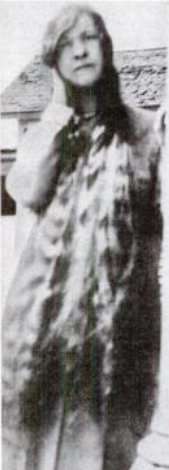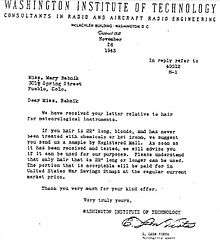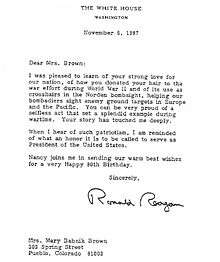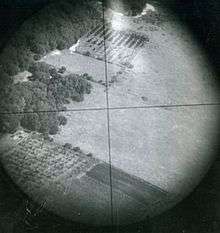Mary Babnik Brown
| Mary Babnik Brown | |
|---|---|
 | |
| Born |
November 22, 1907 Pueblo, Colorado |
| Died |
April 14, 1991 (aged 83) Pueblo, Colorado |
| Occupation | Laborer, labor leader |
| Parent(s) | Frank Wolf Babnik[1] and Mary Babnik[2] |




Mary Babnik Brown (November 22, 1907 – April 14, 1991) was an American who became known for having donated her hair to the United States military during World War II. Thirty-four inches long (86 cm), her blonde hair had never been chemically treated or heated with curling irons, and therefore proved resilient enough to use as crosshairs in Norden bombsights for bomber aircraft, which have to withstand a wide range of temperatures and humidity.[3]
Brown was never compensated for her donation; she was offered war savings stamps, but turned them down, believing what she had done was her patriotic duty.[2] She was told at the time only that the hair was needed for meteorological instruments, and had no idea how it had been used until 1987.[4] President Ronald Reagan wrote to her that year on her 80th birthday to thank her, and in 1991 she received a special achievement award from the Colorado Aviation Historical Society during a ceremony at the Air Force Academy in Colorado Springs.[3]
Early life
Brown (née Babnik, often misspelled Babnick) was born in Pueblo, Colorado, to Frank and Mary Babnik, immigrants from Slovenia. Her father worked at the railroad and her mother was a domestic helper. Her parents named her Mitzi, a Slovenian name, but she Americanized it to Mary. The oldest of the children, she had three younger siblings; her sister, Josephine, arrived in 1908, followed by two brothers, Frank in 1910 and Joseph in 1912. Brown spent her early childhood in the Bessemer and Grove neighborhoods of Pueblo. Her father abandoned the family around 1920, leaving her mother to raise the children.[1][5]
Brown left elementary school when she was 12 years old to help support the family. She first obtained part-time domestic work for $5 a week.[2] By lying about her age when she was 13, she was able to find a permanent job at the National Broom Factory, which paid 75 cents a day when she started; she ended up working there for 42 years. Her siblings contributed to the family financially by picking up chunks of coal on railroad tracks that had fallen from steam-engine trains.[5]
Brown became a well-known dancer in Pueblo. She began dancing as a hobby in her early teens, winning her first dancing contest at the age of nineteen. She danced so often at the Arcadia Ballroom (now razed) on Fifth Street in downtown Pueblo that her nickname was "Arcadia Mary". During World War II she taught GIs how to dance. She had a saying: "My first love is my family, but dancing is my second."[5]
Hair donation
In 1944 Brown was the first woman to have her hair used for military aircraft bombsights.[6] She saw an advertisement in a Pueblo newspaper in 1943 that said the government was looking for hair from women for the war effort, although no details were given as to how it would be used. The ad said only that they wanted blonde hair that was at least 22 inches long (56 cm), and which had not been treated with chemicals or hot irons. The women's hair collection for use as bombsight crosshairs was a clandestine operation even though they found the hair through a newspaper advertisement.[7][8]
The Army Air Forces had tried several different materials for the crosshairs of the Norden bombsight, a carefully guarded, state-of-the-art instrument that aimed bombs at their target.[4][7] The bombsight was used on the B-24 Liberator, B-29 Super Fortress and B-17 Flying Fortress military aircraft.[9] It was so advanced that it was surrounded by booby-trapped charges that the crew were ordered to detonate if it appeared that the bombsight might be seized by the enemy.[4][10][11]
According to Doug Adams, black widow spider webbing had been tried for the crosshairs, but it could not withstand the variations in temperature to which the bombsight would be exposed. In contrast, fine blonde human hair that had not been treated with chemicals or heat was found to be reliable in a wide range of climatic conditions, including at 20,000 feet and below freezing.[12][13]
Brown's hair was 34 inches (86 cm) long and had never been cut, chemically treated or heated with irons. It was her most prized possession. She washed it with "pure soap" twice weekly and combed it twice a day; it stretched down to her knees when she combed it out. She normally wore it wrapped around her head in a braid, and as a result was known as the "lady with the crown".[2][14][15]
The government purchasing agent at the Washington Institute of Technology told her that her hair would be used for meteorological instruments.[16] She sent off samples, and they concluded that it would be appropriate for the crosshairs.[17] Brown agreed in 1944 to have it cut. The government offered to pay her for it in war savings stamps, but she refused, seeing it as her duty to help in the war effort.[2] She ended up feeling traumatized by the loss of it, and cried for two months afterwards.[11]
As well as being used for bombsight crosshairs, Brown's hair was also used in scientific equipment to make precise measurements of humidity, paramount in the production of military aircraft and other war equipment.[18] Brown's hair was the first woman's hair used as crosshairs in military aircraft bombsights.[19][20]
Later life
Brown married Carl Brown sometime after 1944, and became Mary "Mitzi" Babnik Brown. In 1947 she became vice president of the State Federation of Labor, the first woman to hold that position.[5] She also became an active member of the Pueblo Democratic party, and was the vice president and president of the Slovenian Lodge SNPJ (Slovenian National Benefit Society).[1] She spent her last years of her life in the 300 block of Spring Street in Pueblo.[5]
Awards and honors
- Brown received a special achievement award on November 17, 1990, from the Colorado Aviation Historical Society in a ceremony at the U.S. Air Force Academy.[7] She was inducted into their Hall of Fame.[21][22]
- Paul Harvey told Brown's story on his nationally broadcast program The Rest of the Story, on November 19, 1990.[5]
- The city of Pueblo, Colorado, declared November 22, 1991, as "Mary Babnik Brown Day". The formal ceremony of medical personnel at a banquet at the Pueblo Country Club was recorded by NBC-TV. It aired the following month on NBC's The Story Behind the Story.[1]
Footnotes
- 1 2 3 4 Pitts, Gail (April 16, 1991). "Pueblo's Mary Babnik Brown dies at 83 in her family home". The Pueblo Chieftain. Pueblo, Colorado.
- 1 2 3 4 5 Gibney, Jim (July 5, 1987). "Pueblo woman's hair went to war – a blond bomber". The Denver Post. Denver, Colorado.
- 1 2 Donovan, Dick (January 15, 1991). "America honors woman whose hair helped win WW2," Weekly World News, p. 43.
- Reagan, Ronald (November 6, 1987). Letter, White House.
- 1 2 3 Denver Post. July 5, 1987: "The popular, prize-winning dancer, known around Pueblo as "Arcadia Mary," didn't know at the time her blond hair was destined for use as crosshairs in the famed Norden bombsight, one of the most carefully protected secrets of World War II."
- 1 2 3 4 5 6 Smith, John Elvans (2001), Mary Babnik and her hair, Pueblo, Colorado: Pueblo Lore magazine, pp. 3–8
- ↑ Read, Phyllis J.; Witlieb, Bernard L. (1992). The Book of Women's Firsts: Breakthrough Achievements of Almost 1,000 American Women. Random House Information Group. p. 71.
Mary Babnick. First woman to have her hair used in a bombsight (1942). Brown's hair, donated to the war effort in response to an advertisement, was thirty-four inches long [86 cm] when she submitted it for experimental use as the crosshairs in a new aiming device, the Norden bombsight."
- McHugh, Erin (2008). Who? What? When? Where? Why?: A Substantial Gathering of Intriguing & Delightful Knowledge. Reader's Digest Association, Inc. p. 18.
Mary Babnick Brown was the first woman whose hair (blonde, 34 inches long) was used as crosshairs in World War II B-17 bombsights.
- McHugh, Erin (2008). Who? What? When? Where? Why?: A Substantial Gathering of Intriguing & Delightful Knowledge. Reader's Digest Association, Inc. p. 18.
- 1 2 3 "A.F. lauds woman who gave hair". www.deseretnews.com. Desert News newspaper. 2013. Retrieved 1 January 2014. "What she didn't know back in 1942 was that her hair was used as cross hairs in a secret bombsight used on bombers."
- ↑ Smith, John Elvans (2001), "Mary Babnik and her hair", Pueblo Lore, Pueblo, Colorado, p. 8,
Through all the years Mary said she was never told what became of her hair.
- ↑ Read, Phyllis J.; Witlieb, Bernard L. (1992). The Book of Women's Firsts: Breakthrough Achievements of Almost 1,000 American Women. Random House Information Group. p. 71.
The bombsight, used in the B-17 Flying Fortressses, B-24 Liberators, and B-29 Super Fortresses was a carefully guarded military secret
- ↑ Desert News, "A.F. Lauds Woman Who Gave Hair", November 19, 1990: "Used on the B-24 Liberator, the B-29 Super Fortress and the B-17 Flying Fortress, the Norden bombsight was so secret that it was equipped with explosives, Feder said, and crews were ordered to destroy it if their bomber ran the risk of falling into enemy hands."
- 1 2 Adams, Doug (2011). "The Blonde and the Bomber: The Hair that Whipped Hitler". Life In The Delta February. Retrieved 2 January 2014. "Mary Babnick Brown's contribution to the war effort was TOP SECRET, as closely guarded as were Norden bombsights. Not until 1987 did she learn that her hair had been used for virtually every Norden bombsight produced. 'I couldn't believe it when they told me,' Mrs. Brown mused. 'All I knew was that they needed virgin hair.'" "Mrs. Brown recalled, 'After I did it I cried and cried. I went to my mother and said, 'Mama, why did you let me cut my hair?' It was two months before I went anywhere except to work ...and I wore a bandanna there.'"
- ↑ "Some gave their lives for the war effort; Mary Babnick Brown gave her hair". Toledo Blade. Toledo, Ohio. Nov 30, 1990. "What she didn't know back in 1942 was that her hair was used as cross hairs in a secret bombsight used in bombers."
- ↑ Desert News newspaper, "A.F. LAUDS WOMAN WHO GAVE HAIR", Published: Monday, Nov. 19 1990. "At altitudes as high as 20,000 feet the bombsight cross hairs were subjected to freezing temperatures and rapid changes in humidity. Black widow spider webs, which contracted and expanded on scale under those conditions, were originally used but were fragile and hard to come by. Feder said Brown's fine blonde hair, which had never been bleached or touched with a hot iron, was unique and shared many of the qualities valued in the black widow spider's web."
- ↑ Denver Post. July 5, 1987. First two paragraphs of newspaper article: "PUEBLO- Mary Babnik had long hair in the early 1940s. Her blond tresses, normally worn braided atop her head, stretched 34 inches to her knees when she combed them out. At 36, Mary was proud of her hair, combing it twice a day and washing it with pure soap twice a week."
- ↑ Mitchel, Karen (2002–2012). "Pueblo County, Colorado / Mary Babnick Brown". Retrieved 2 January 2014. "She had begun braiding her hair as a toddler and called it her crowning glory. 'I had never had it cut,' she said. "I cried for two months . . I sent them all of it In 1942, Mary Babnik Brown was known as 'the lady with the crown' because of the long braided hair she wore wrapped around her head."
- ↑ E. Leon Virts, US government purchasing agent (November 26, 1943). Letter, Washington Institute of Technology.
- ↑ "Two Puebloans earn Aviation Hall of Fame - p8A". The Chieftain. Pueblo: The Chieftain newspaper. November 11, 1990.
- ↑ "Woman's locks key to sights". Star News. Colorado Springs, Colorado: Star News newspaper. Nov 22, 1990. Retrieved 6 Jan 2014.
- ↑ McHugh 2008, p. 18 Mary Babnick Brown was the first woman whose hair was used as crosshairs for World War II B-17 bombsights..
- ↑ Read & Witlieb 1992, p. 71. "Mary Babnick. First woman to have her hair used in a bombsight (1942). Brown's hair, donated to the war effort in response to an advertisement, was thirty-four inches long when she submitted it for experimental use as the crosshairs in a new aiming device, the Norden bombsight."
- ↑ Desert News newspaper. "A.F. LAUDS WOMAN WHO GAVE HAIR" Published: Monday, Nov. 19 1990: "Bill Feder, founder of the International B-24 Memorial Museum in Pueblo, learned recently that a Pueblo woman had donated her hair, and he began looking for her. He told Brown that her hair was used experimentally as cross hairs in a bomb-aiming device known as the Norden bombsight."
- ↑ Pueblo Chieftain newspaper. "Two Puebloans earn Colorado Aviation Hall of Fame" Published: Sunday, Nov. 11 1990: "Two Puebloans will be among eight inducted into the Colorado Aviation Hall of Fame at 1 P.M. Nov. 17 at the U.S. Air Force Academy Officers Club near Colorado Springs. The special achievement award will go to Mrs. Brown. Her long, golden hair was given to the Air Force for use in the Norden bombsight. The hair was the exact thickness needed for crosshairs in the bombsight."
Bibliography
- McHugh, Erin (2008). Who? What? When? Where? Why?: A Substantial Gathering of Intriguing & Delightful Knowledge. Reader's Digest Association, Inc. ISBN 978-0-7621-0557-1.
- Read, Phyllis J.; Witlieb, Bernard L. (1992). The Book of Women's Firsts: Breakthrough Achievements of Almost 1,000 American Women. Random House Information Group. ISBN 978-0-679-40975-5.
External links
|
| |
|
|
